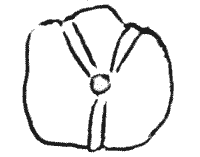
COCONUTS
SCIENTIFIC NAME: Cocos nucifera
FAMILY: Arecaceae
Resumé of a talk by Buddy Rosello
Buddy commenced by tracing the history of coconuts in Australia. There was no evidence of coconuts pre-European settlement, just one tree sighting being recorded on Brampton Island. The first commercial plantings were some 40 acres in Fingal Bay around 1890, followed by Bramston Beach, Mission Beach, Dunk Island and others from Innisfail north. Plantings probably came about following the slump at the turn of the century but most plantations failed because they matured at the time of the first world war when transport was almost impossible. Many of these original plantings are still evident today.
Coconut trees will grow in latitudes from 10° to 23° but will bear only in the more northerly areas (e.g. they grow but do not bear in Brisbane).
Australian consumption of coconut products in 1979/80 were valued at some $20 million in the form of oil, soap, margarine, biscuits, cakes and shell products.
Based on the current cost of coconut in shells (as opposed to copra) a hectare of palms would yield a gross income of around $6500. Buddy calculated the amount of labour per hectare to maintain a small plantation would be around 39.5 man days per annum, or say about $1500 per acre, giving a profitability of $5000 per hectare. Economically very feasible.
Only two major varieties of coconuts exist, the tall palm so commonly seen around the N. Queensland coast and the dwarf palm which originates in Malaysia. The dwarf palm is self pollinating whilst the tall palm is not and, although wind-borne pollen can be carried considerable distances, it is recommended to plant the tall palms other than singly.
Planting distances for dwarfs are 7 metres whilst 8/10 metres are required for the tall varieties. Nuts take 12 months from pollination to full maturity. However, if you want to eat the flesh, they are best harvested around 8 months.

Nuts are usually grown in a nursery and Buddy gave us a very useful tip to help propagation. When husked, a nut shows three 'eyes', one large and two small. From the larger comes the stem whilst the roots emerge from the two smaller eyes. The problem is how to tell from an unhusked nut. He told us that the husk, when viewed from the end, showed 3 segments. The smaller one is the one containing the trunk 'eye' and should therefore be planted uppermost to speed germination.
There are many planting systems and the one he recommended was to scoop a depression about half the depth of the nut and lay the nut in it.
On the question of temperature, his research showed no detrimental effect from cold weather in N. Queensland, even to the extent of a touch of frost. Nuts will grow from the sea to about 50 kilometres inland. Coconut palms need well-drained soil with a water table no deeper than 10-20 feet.
There are very few pests and diseases in Australia.
The talk aroused great interest and a considerable number of questions were raised vide:
Selection of planting material: Many factors, e.g. condition of mother tree, its production volume, size of nuts, thickness of flesh etc. Preferably from a mature tree about 25 years old and 30' high. Shape of nut can be a factor.
Time of maturity: Dwarf trees will flower in three years but wait 15 years before taking nuts for seed.
Economic age of trees: 30 for a dwarf and up to 60 for the tall.
Size of root system: As far as the radius of the leaves.
Food value of nuts: No variation with age, although the younger nut is sweeter.
Height above sea level: Coconuts need salt. According to the book, 600 metres is the maximum elevation (Buddy feeds chlorine to his trees.)
Cross pollination: There is no reason why the dwarf and the tall varieties should not cross pollinate if all conditions are right.
All in all a most interesting talk which gave us all food for thought.
DATE: March 1981
* * * * * * * * * * * * *
